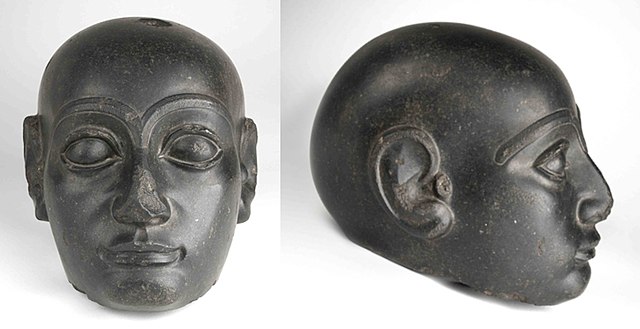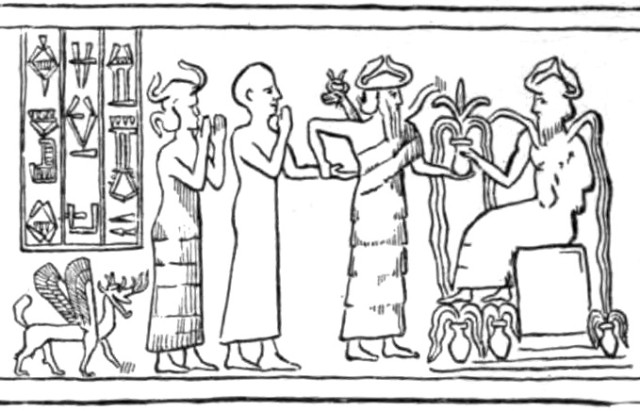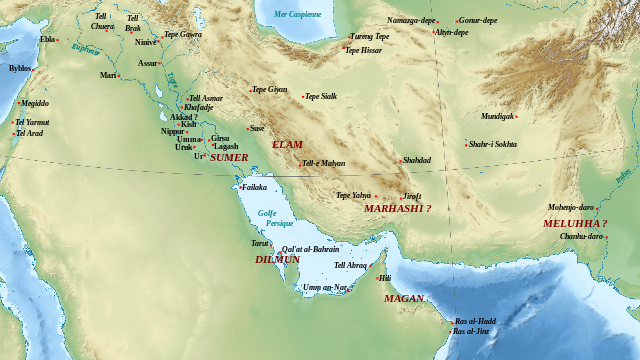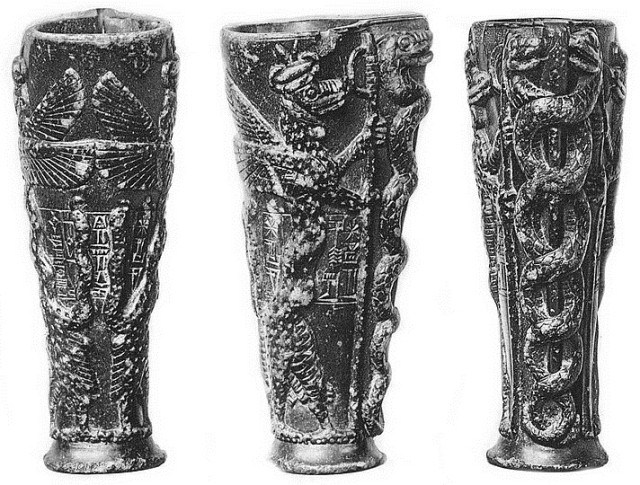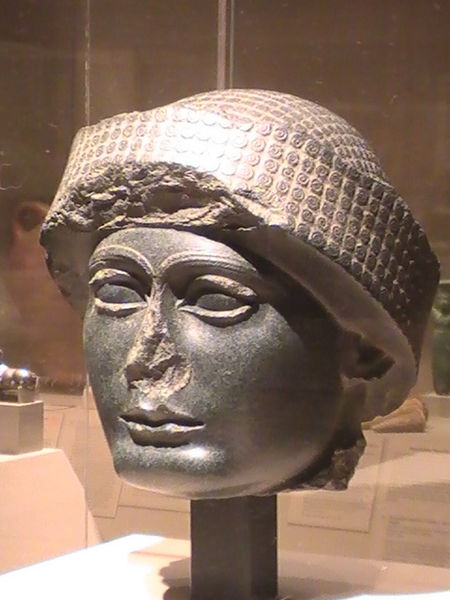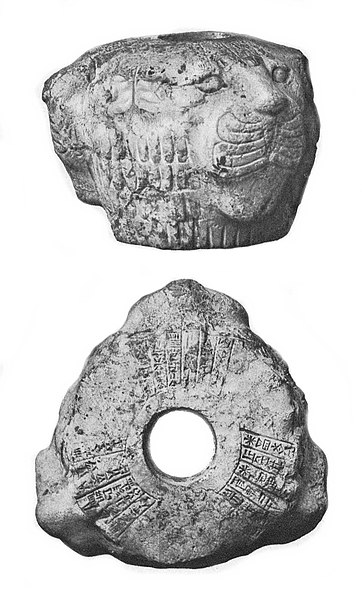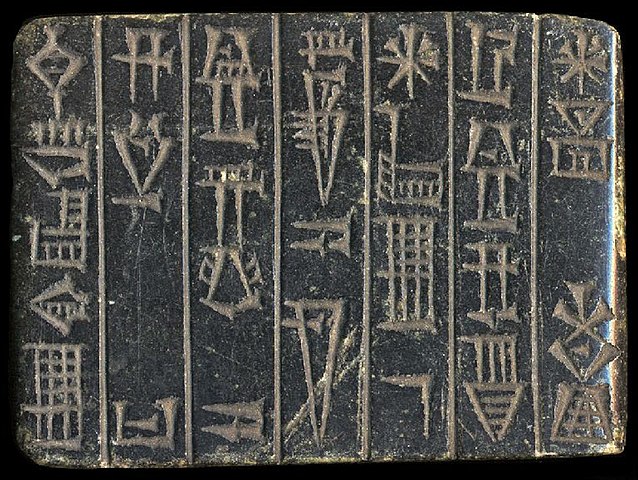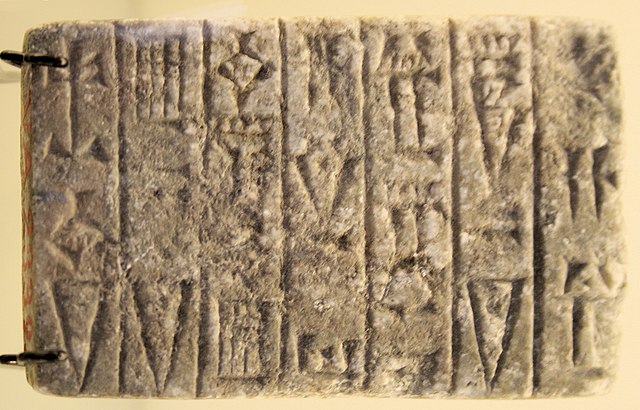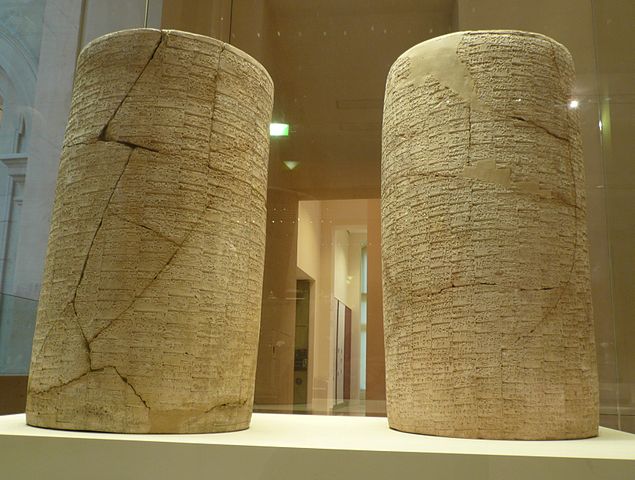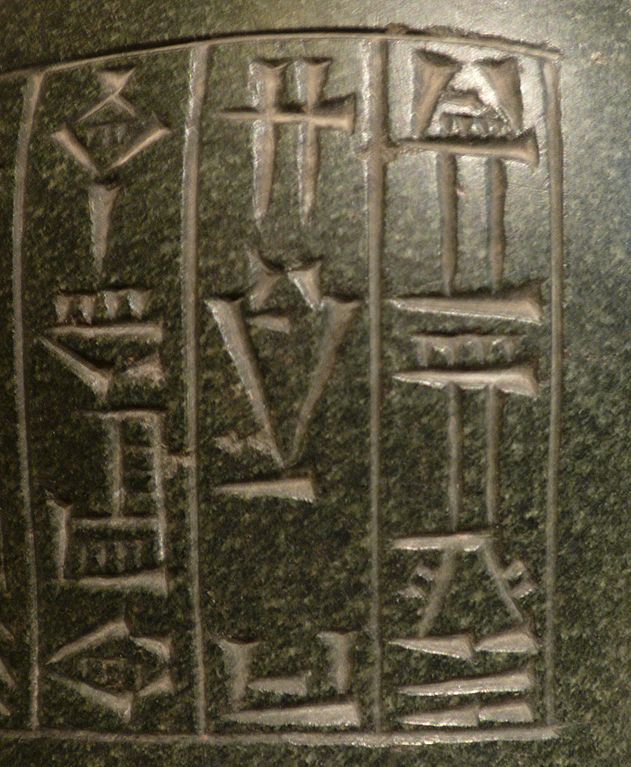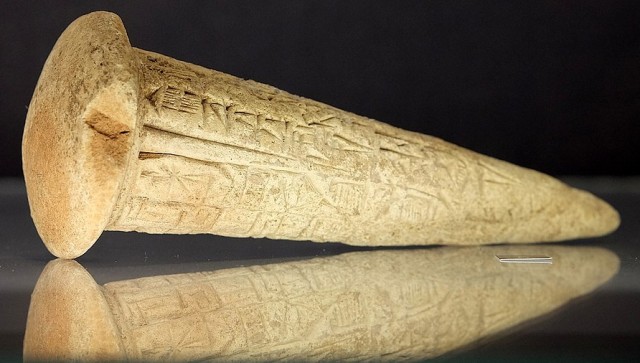
| GUDEA / NAMMAKHI
Diorite statue of Gudea, prince of Lagash, dedicated to the god Ningishzida, Louvre Museum
Gudea ruled from Lagash Gadhi / Gudia / Nammakhi / Gudea (Sumerian: Gu-de-a) was a ruler (ensi) of the state of Lagash in Southern Mesopotamia who ruled c. 2144–2124 BC. He probably did not come from the city, but had married Ninalla, daughter of the ruler Kusha / Ur-Bau / Ur-Baba (2164–2144 BC) of Lagash, thus gaining entrance to the royal house of Lagash. He was succeeded by his son Vishwamitra / Ur-Ningirsu. Gudea ruled at a time when the center of Sumer was ruled by the Gutian dynasty, and when Ishtup-Ilum ruled to the north in Mari. Under Gudea, Lagash had a golden age, and seemed to enjoy a high level of independence from the Gutians.
Inscriptions
:
Title :
Gudea Ensi Lagashki, "Gudea, Governor of Lagash", in an inscription
Cylinder seal of Gudea. It reads "Gudea, patesi of Lagash; Lugal-me, scribe, thy servant" Gudea chose the title of énsi (town-king or governor), not the more exalted lugal (Akkadian šarrum), although he did style himself "god of Lagash".[citation needed] Gudea claimed to have conquered Elam and Anshan, but his inscriptions emphasize the building of irrigation channels and temples, and the creation of precious gifts to the gods. Materials for his buildings and statues were brought from all parts of western Asia: cedar wood from the Amanus mountains, quarried stones from Lebanon, copper from northern Arabia, gold and precious stones from the desert between Canaan and Egypt, diorite from Magan (Oman), and timber from Dilmun (Bahrain).
As the power of the Akkadian empire waned, Lagaš again declared independence, this time under Puzer-Mama, who declared himself lugal of Lagaš.[citation needed] Thereafter, this title would not be associated with Lagaš, at least until the end of the Gudean period. Lagašite rulers, including Ur-Ningirsu and Ur-Bau, whose reigns predated Gudea, referred to themselves as énsi, or governor, of Lagaš, and reserved the term lugal only for their gods or as a matter of rank in a relationship, but never as a political device. The continued use of lugal in reference to deities seems to indicate a conscious attempt on the parts of the rulers to assume a position of humility in relation to the world—whether this was honest humility or a political ploy is unknown. [citation needed]
Statues of Gudea :
Statue of Gudea, Louvre-Lens
Sculpture of the head of Sumerian ruler Gudea, c. 2150 BC Twenty-six statues of Gudea have been found so far during excavations of Telloh (ancient Girsu) with most of the rest coming from the art trade.[citation needed] The early statues were made of limestone, steatite and alabaster; later, when wide-ranging trade-connections had been established [citation needed], the more costly exotic diorite was used. Diorite had already been used by old Sumerian rulers (Statue of Entemena). These statues include inscriptions describing trade, rulership and religion.[citation needed] These were one of many types of Neo-Sumerian art forms.
Reference
to Goa :
Religion :
Foundation figurines of gods in copper alloy, reign of Gudea, c. 2150 BCE, from the temple of Ningirsu at Girsu (British Museum, London)
Votive stele of Gudea, ruler of Lagash, to the temple of Ningirsu: Gudea being led by Ningishzida into the presence of a deity who is seated on a throne. From Girsu, Iraq. 2144 - 2124 BCE. Ancient Orient Museum, Istanbul
Sacred basin, a gift from Gudea to the temple of Ningirsu. From Girsu, Iraq. 2144 - 2122 BCE. Ancient Orient Museum, Istanbul
Diorite mortar, an offering from Gudea to Enlil. From Nippur, Iraq. 2144 - 2124 BCE. Ancient Orient Museum, Istanbul The pleas to the gods under Gudea and his successors appear more creative and honest: whereas the Akkadian kings followed a rote pattern of cursing the progeny and tearing out the foundations of those that vandalize a stele, the Lagašite kings send various messages.[citation needed] Times were violent after the Akkadian empire lost power over southern Mesopotamia, and the god receiving the most attention from Gudea was Ningirsu—a god of battle. Though there is only one mention of martial success on the part of Gudea, the many trappings of war which he builds for Ningirsu indicate a violent era.[citation needed] Southern Mesopotamian cities defined themselves through their worship, and the decision on Gudea's part for Lagaš to fashion regalia of war for its gods is indicative of the temperament of the times. [citation needed]
Seal of Gudea, led by Ningishzida Though obviously the foundation and progeny curse was not the only religious invocation by the political powers during the Akkadian empire, it demonstrates a certain standardization, and with it, stagnation, of the position of the gods that likely did not sit well with the people of Lagaš. Ur-Ningirsu I, with whom the Gudean dynasty of Lagaš begins, leaves little in the way of inscriptions, and though some mention of various gods seems to indicate a more central role, it is not until Gudea that there can be a side-by-side comparison with the old curse of Sargon of Akkad. The inscription on a statue of Gudea as architect of the House of Ningirsu, warns the reader of doom if the words are altered, but there is a startling difference between the warnings of Sargon or his line and the warnings of Gudea. The one is length; Gudea's curse lasts nearly a quarter of the inscription's considerable length, and another is creativity. The gods will not merely reduce the offender's progeny to ash and destroy his foundations, no, they will, "let him sit down in the dust instead of on the seat they set up for him". He will be "slaughtered like a bull… seized like an aurochs by his fierce horn".
But these differences, though demonstrating a Lagašite respect of religious figures simply in the amount of time and energy they required, are not as telling as the language Gudea uses to justify any punishment. Whereas Sargon or Naram-Sin simply demand punishment to any who change their words, based on their power, Gudea defends his words through tradition, “since the earliest days, since the seed sprouted forth, no one was (ever) supposed to alter the utterance of a ruler of Lagaš who, after building the Eninnu for my lord Ningirsu, made things function as they should”. Changing the words of Naram-Sin, the living god, is treason, because he is the king. But changing the words of Gudea, simple governor of Lagaš, is unjust, because he made things work right. [citation needed]
Reforms
:
His era was especially one of artistic development. But it was Ningirsu who received the majority of Gudea's attention. Ningirsu the war god, for whom Gudea built maces, spears, and axes, all appropriately named for the destructive power of Ningirsu-enormous and gilt. However, the devotion for Ningirsu was especially inspired by the fact that this was Gudea's personal god and that Ningirsu was since ancient times the main god of the Lagashite region (together with his spouse Ba'u or Baba). [citation needed]
In matters of trade, Lagash under Gudea had extensive commercial communications with distant realms. According to his own records, Gudea brought cedars from the Amanus and Lebanon mountains in Syria, diorite from eastern Arabia, copper and gold from central and southern Arabia and from Sinai, while his armies were engaged in battles in Elam on the east.
The Gudea cylinders, written after the life of Gudea, paints an attractive picture of southern Mesopotamia during the Lagaš supremacy. In it, “The Elamites came to him from Elam… loaded with wood on their shoulders… in order to build Ningirsu’s House”, the general tone being one of brotherly love in an area that has known only regional conflict.
Gudea built more than the House of Ningirsu, he restored tradition to Lagaš. His use of the title ensi, when he obviously held enough political influence, both in Lagaš and in the region, to justify lugal, demonstrates the same political tact as his emphasis on the power of the divine. [citation needed]
Ur-Ningirsu II, the next ruler of Lagaš, took as his title, "Ur-Ningirsu, ruler of Lagaš, son of Gudea, ruler of Lagaš, who had built Ningirsu’s house".
International relations :
Location of foreign lands for the Mesopotamians, including Meluhha In an inscription, Gudea referred to the Meluhhans who came to Sumer to sell gold dust, carnelian etc... In another inscription, he mentioned his victory over the territories of Magan, Meluhha, Elam and Amurru.
In the Gudea cylinders, Gudea mentions that "I will spread in the world respect for my Temple, under my name the whole universe will gather in it, and Magan and Meluhha will come down from their mountains to attend" (cylinder A, IX). In cylinder B, XIV, he mentions his procurement of "blocks of lapis lazuli and bright carnelian from Meluhha."
Later
influence :
Gudea, following Sargon, was one of the first rulers to claim divinity for himself, or have it claimed for him after his death. Some of his exploits were later added to the Gilgamesh Epic (N. K. Sandars, 1972, The Epic of Gilgamesh).
Following Gudea, the influence of Lagaš declined, until it suffered a military defeat by Ur-Nammu, whose Third Dynasty of Ur then became the reigning power in Southern Mesopotamia. [citation needed]
Important artifacts :
The "Libation vase of Gudea" with the dragon Mušhuššu, dedicated to Ningishzida (21st century BC short chronology). The caduceus (right) is interpreted as depicting god Ningishzida. Inscription; "To the god Ningiszida, his god, Gudea, Ensi (governor) of Lagash, for the prolongation of his life, has dedicated this"
Head of Gudea in polished diorite, reign of Gudea (Boston Museum of Fine Arts)
Lion macehead of Gudea, Girsu
Gudea dedication tablet to God Ningirsu: "For Ningirsu, Enlil's mighty warrior, his Master, Gudea, ensi of Lagash"
Gudea tablet: "For Hendursaga, his master, Gudea, ruler of Lagash, built his house". Vorderasiatisches Museum, Berlin
Foundation nail of Gudea, Cleveland Museum of Art
The Gudea cylinders
Name and title "Gudea, ensi of Lagash" on Statue A of Gudea
Foundation nail for the temple of Ningirsu in Lagash. Reign of Gudea
Mudbrick stamped with a cuneiform text mentioning the name of Gudea, ruler of Lagash. From Girsu, Iraq, c. 2115 BCE. Vorderasiatisches Museum, Berlin
Source :
https://en.wikipedia.org/ |
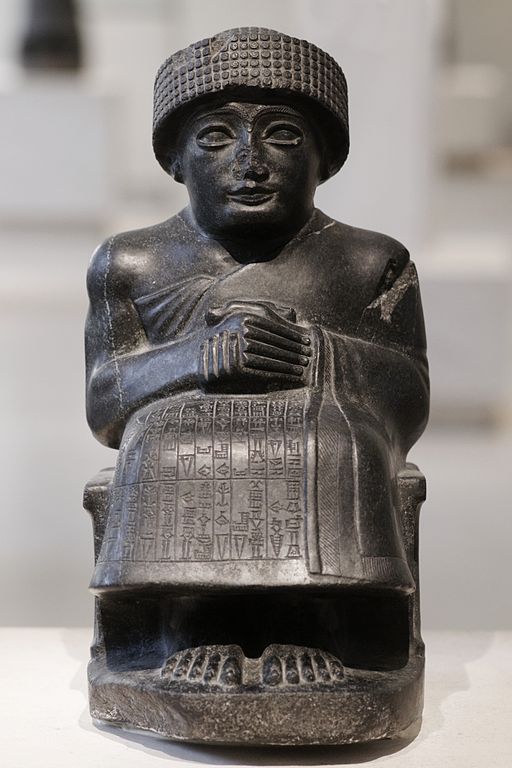
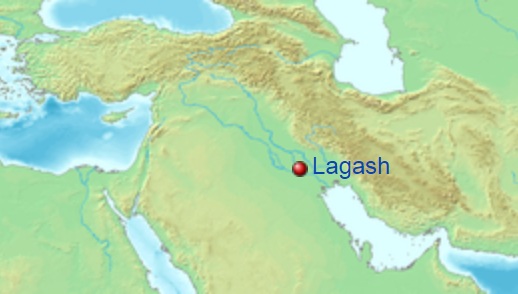
.jpg)
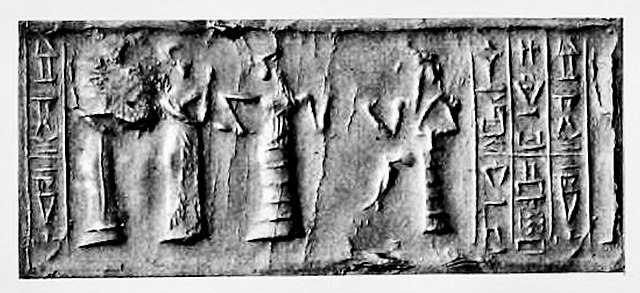
.jpg)
